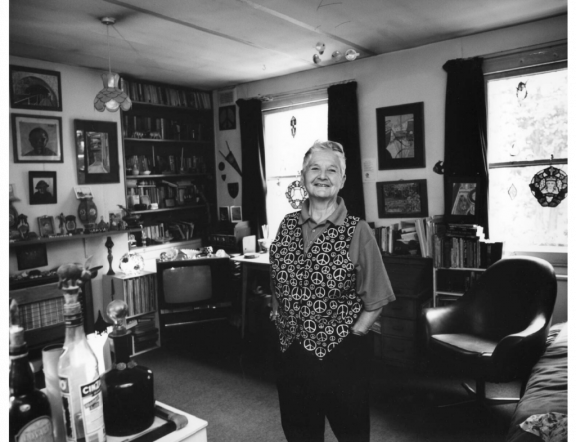
Over its 800-year history, Cambridge University has taught countless numbers of LGBT+ students. We all know some of the more recent names: national treasures Ian McKellan, Sandi Toskvig, Stephen Fry and Sue Perkins have all lived and studied in the city we call home. Here are three other queer alumni you should know about.
Over its 800-year history, Cambridge University has taught countless numbers of LGBT+ students. We all know some of the more recent names: national treasures Ian McKellan, Sandi Toskvig, Stephen Fry and Sue Perkins have all lived and studied in the city we call home.
Here are three other queer alumni you should know about:
Edward Carpenter (1844-1929) was a notable poet, philosopher and activist. His “unconventional” lifestyle and views pushed the boundaries of late Victorian middle class thinking, and he was a pioneering supporter of causes that we today take for granted – women’s rights, sexual reform, recycling, vegetarianism and gay rights.
Carpenter was born in Hove to a wealthy family and read maths at Trinity Hall College in the 1860s, then staying on as a lecturer and Dean. It was at Trinity Hall that he first started exploring his feelings for men after discovering the homoerotic poems of Walt Whitman. He wrote about his experience of being gay at Cambridge in his autobiography: “What curious romance ran through all that life – and yet on the whole, with few exceptions, how strangely unspoken it was and unexpressed! The succession of athletic and even beautiful faces and figures, what a strange magnetism they had for me, and yet all the while how unsurmountable for the most part was the barrier between! It was as if a magic flame dwelt within one, burning, burning, which one could not put out, yet whose existence one might on no account reveal.”
After leaving Cambridge Carpenter travelled widely, lecturing and publishing poetry and novels. In 1891 he met George Merrill, a younger working class man from Sheffield, and the pair set up a household together in Surrey, living openly as romantic partners for 30 years in defiance of Victorian sexual values and class structure. This was revolutionary at a time when hundreds of men were being prosecuted for homosexuality. Carpenter published books including Homogenic Love, (1895), Love’s Coming of Age (1986) and The Intermediate Sex (1908) defending homosexuality and advocating greater tolerance of same-sex love.
Goldsworthy Lowes Dickinson (1862-1932), known to his friends as “Goldie”, was a political scientist and philosopher, who lived in Cambridge as an academic for most of his life. He is best known for his contributions to the study of international relations, including his support for the formation of the League of Nations (now the United Nations).
Dickinson was also a classicist, with a fascination for Ancient Greece. His book The Greek View of Life (1896) is unusually open about the homoeroticism of Ancient Greece. This was usually glossed over by academics of the time, but in his book Dickinson discusses the “passionate friendship between men” that existed in Greek society, citing examples of famous Greek male couples and stating: “This passion, like any other, has its depths, as well as its heights.” Equating relationships between two men to heterosexual relationships may not sound revolutionary now, but the book was published one year after Oscar Wilde was prosecuted for homosexuality, and it was a bestseller in its day.
In his Autobiography, only published 40 years after his death, Dickinson was remarkably candid about his sex life. He describes numerous crushes on male students, and how he fell in love with several of his (mostly straight) friends – although seemingly never acted on it. He also writes about his fetish for boots and feet! Dickinson’s Autobiography makes no apology for his being gay and shows that, although he kept his sexuality largely private, he felt no shame in it.
Pat Arrowsmith (1930-) is an anti-nuclear protestor, poet, novelist and peace activist. Arrowsmith has been a rebel all her life: she was first expelled from school at the age of 14. Whilst reading history at Newnham College, Cambridge, she would bunk off lectures to give speeches of her own to factory workers in Letchworth and attend demonstrations with the peace movement, ‘Crusade for World Government’. After leaving Cambridge, in 1958 Arrowsmith organised the first protest in the UK against nuclear weapons, and co-founded the Campaign for Nuclear Disarmament. She has been imprisoned no less than 11 times for her campaigning activities: she was force fed whilst on hunger strike in 1961, leading to a debate on the practice in the UK Parliament, and in 1976 she escaped from prison by climbing over a fence!
Arrowsmith never kept her sexuality a secret. When her father, a Church of England vicar, died in 1976, Arrowsmith found she was unable to claim her inheritance unless she married a man. So – she married her anarchist poet friend Donald Gardner, and annulled it the same day. She donated her inheritance money to a variety of causes, including Gay Pride Week 1979 and Sappho magazine. By 1977 Arrowsmith had achieved enough notoriety to be profiled in the influential Who’s Who magazine, where she became the first person to out herself in its pages.
John Mason – Volunteer
Image = National Portrait Gallery https://www.npg.org.uk/collections/search/portrait/mw14430/Pat-Arrowsmith?LinkID=mp13736&role=sit&rNo=0
Further reading:
Edward Carpenter Autobiography https://web.archive.org/web/20170520180805/http://www.edwardcarpenter.net/ecdd1.htm
Goldsworth Lowes Dickinson biography: http://www.glbtqarchive.com/literature/dickinson_gl_L.pdf
Pat Arrowsmith interview: https://www.theguardian.com/society/2008/apr/30/6
